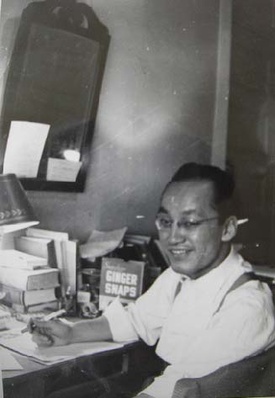What kind of person was John Okada, the author of "No-No Boy"? He was not famous as a professional writer, and there are not many records left about him.
His career is detailed in the preface to the new edition by Ruth Ozeki, as well as in "Art, Literature, and the Japanese American Internment: On John Okada's No-No Boy" (by Thomas Girst), published last year. Based on these, I will trace Okada's life.
John Okada was born on September 23, 1923 (Taisho 12) in a room at the Merchant Hotel in Pioneer Square in the heart of Seattle, as the second son of his father, Yoshito Okada (Fred Okada), and mother, Takayo.
Zento was born in Kabe-cho, Asa-gun, Hiroshima Prefecture in 1894, and was invited to America in 1908 by his father, who had come earlier. He saved up money by working on the railroad in Montana and as a store clerk in Seattle, before returning to Japan and marrying Takayo.
The Okada family ran several hotels in the city, including one that opened in 1920. John attended the local Bailey Gatxert Elementary School and Broadway High School. He was an excellent student and had good athletic ability.
After being incarcerated, he volunteered for the military.
He went on to the University of Washington in Seattle, where he took classes on novel and screenplay writing and showed an interest in English literature. In 1942, shortly after the start of the war, during his second year at university, the Okada family was interned at the Puyallup Assembly Center on the outskirts of Seattle, along with other Japanese Americans, as part of the US government's segregation and internment policy against Japanese Americans that began all at once on the West Coast. They were then sent to an internment camp in Minidoka, in the desert of Idaho.
While in the camp, John was allowed to attend junior college in Lincoln, Nebraska, where he enlisted in the military, first training as a Japanese interpreter at Camp Savage, Minnesota's Military Intelligence Service, then further basic training in Jacksonville, Florida, before being commissioned as a member of the Air Force National Guard.
Based in Guam, the unit conducted reconnaissance flights within Japan's air superiority zone, and John served as an interpreter over the South Pacific, intercepting communications between Japanese fighter planes and ground bases and translating these into English.
After the war, he served as an interpreter for the occupying forces for five months, and spent some time in Japan. In 1946, he returned to Seattle and returned to school at the University of Washington, where he earned a Bachelor of Arts degree. He then went on to study at Teachers College, Columbia University in New York, where he earned a Master of Arts degree. During this time, he met and married Dorothy Arakawa, a second-generation Japanese-American from Hawaii, and later had one son and one daughter.
Job changes and moves
After this, she returned to Seattle and studied library science at the University of Washington, while at the same time working as an assistant to Doris Mitchell at the Seattle Public Library. In 1952 or 1953, she moved with her family to Detroit in search of a better job, where she got a position at the Detroit Public Library. It seems that she moved to cut off her friendships in Seattle and prepare for her creative endeavors.
A few years later, he became a technical writer for Chrysler's ballistic missile division in Sterling Township, Illinois, 400 miles from Detroit, before returning to the West Coast in 1956 and working as a technical writer for Hughes Aircraft Company, 20 miles southwest of Los Angeles. It was during this time that he wrote "The No-No Boy."
In the mid-1960s, he tried copywriting for an advertising agency and briefly worked in the UCLA library, eventually landing a job as publications manager for Analog Technology, a small manufacturer of products in the aerospace industry, and by 1964 he had bought a home in South San Gabriel, east of Los Angeles.
He lived there with his wife and two children, but died of a heart attack at home on February 20, 1971, at the age of 47. His funeral was held in Los Angeles, and he was cremated in his hometown of Seattle a few months later and buried in Washari Cemetery, which also contains the graves of many Japanese Americans.
(Titles omitted)
© 2016 Ryusuke Kawai







